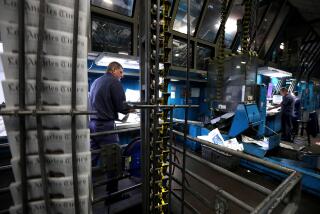Renault Closing ‘Workers’ Fortress’ : Automobiles: The plant on an island in the Seine on Tuesday ends six decades of industrial might and union militancy.
- Share via
PARIS — Known as “the workers’ fortress,” France’s most famous automobile factory closes down Tuesday after six turbulent decades as a symbol of industrial might and union militancy.
About 1 million workers have put in shifts at Renault’s Billancourt plant, a massive, five-story structure on an island in the Seine just outside Paris. Its history includes violent strikes, an era of power for Communist unions and Allied bombing raids prompted by Renault’s collaboration with the Nazis in World War II.
Billancourt was proclaimed “the factory of tomorrow” when it opened in 1929, but it has been overtaken by progress. Renault’s factories elsewhere are more modern and more accessible than the island operation.
The closure comes at a time when France’s leftist unions are struggling to cope with the decline of socialism and pressure from employers to streamline operations. The government remains an active player in many industries, including Renault, but now tends to encourage executives to make tough, profit-oriented decisions even when jobs might be lost.
A small ceremony was held Friday when the assembly line shut down and workers turned in their tools after completing a white Super-Cinq. The only tasks left were technical checks of the vehicles and dismantling of machinery.
“It was poignant and pathetic,” said a union official, Daniel Labbe. “You felt like you were attending a funeral.”
The factory’s death was foretold Nov. 20, 1989, when Renault’s chief executive, Raymond Levy, announced in a videotape shown to workers that closure was planned within three years.
“The Crime” was the headline the next day in the Communist Party newspaper L’Humanite. The Communist General Confederation of Labor envisioned worker protests to stop the plans, but other unions signed an agreement aimed at protecting jobs and no strikes took place.
At its peak in the late 1930s, Billancourt employed 37,000 people and was France’s biggest auto factory, churning out 50,000 cars, buses, trucks and tractors annually.
The work force dwindled to 3,844 by 1989 as Renault built new plants far from Paris. Only 1,100 workers were left as of this weekend.
Many of these workers have obtained transfers or accepted early retirement. But union officials said about 200 were having trouble finding new jobs, and the Communist Party has accused Renault of playing down the traumas faced by the workers and their families.
Renault’s presence in Billancourt predates the island factory. Louis Renault created his first car in a workshop in the area in 1898, then built a factory along the banks of the Seine that produced France’s first taxis in 1905 and made tanks for French forces in World War I.
Renault was among the first French companies to adopt American-style assembly line techniques, including use of the time clock.
Needing expansion room, Renault acquired 30-acre Seguin after World War I.
The 1930s were marked by labor unrest. In one strike, workers scaled Billancourt’s high walls and hurled down their lunch buckets. In 1938, police were summoned to clear away strikers protesting longer work hours.
During World War II, Louis Renault collaborated with the pro-Nazi Vichy regime, and 80% of the factory was destroyed by Allied bombing.
Because of the collaboration, the post-war government took over Renault, which remains state-controlled today.
More to Read
Sign up for Essential California
The most important California stories and recommendations in your inbox every morning.
You may occasionally receive promotional content from the Los Angeles Times.













